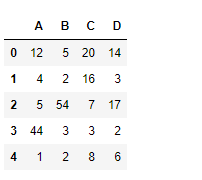Python | Pandas dataframe.melt()
Last Updated :
09 Dec, 2021
Python is a great language for doing data analysis, primarily because of the fantastic ecosystem of data-centric python packages. Pandas is one of those packages and makes importing and analyzing data much easier.
Pandas dataframe.melt() function unpivots a DataFrame from wide format to long format, optionally leaving identifier variables set. This function is useful to message a DataFrame into a format where one or more columns are identifier variables (id_vars), while all other columns, considered measured variables (value_vars), are “unpivoted” to the row axis, leaving just two non-identifier columns, ‘variable’ and ‘value’.
Syntax:DataFrame.melt(id_vars=None, value_vars=None, var_name=None, value_name=’value’, col_level=None)
Parameters :
frame : DataFrame
id_vars : Column(s) to use as identifier variables
value_vars : Column(s) to unpivot. If not specified, uses all columns that are not set as id_vars.
var_name : Name to use for the ‘variable’ column. If None it uses frame.columns.name or ‘variable’.
value_name : Name to use for the ‘value’ column
col_level : If columns are a MultiIndex then use this level to melt.
Returns: DataFrame into a format where one or more columns are identifier variables
Example #1: Use melt() function to set column “A” as the identifier variable and column “B” as value variable.
Python3
import pandas as pd
df = pd.DataFrame({"A":[12, 4, 5, 44, 1],
"B":[5, 2, 54, 3, 2],
"C":[20, 16, 7, 3, 8],
"D":[14, 3, 17, 2, 6]})
df
|

Lets use the dataframe.melt() function to set column “A” as identifier variable and column “B” as the value variable.
Python3
df.melt(id_vars =['A'], value_vars =['B'])
|
Output :

Example #2: Use melt() function to set column “A” as the identifier variable and column “B” and “C” as value variable. Also customize the names of both the value and variable column.
Python3
import pandas as pd
df = pd.DataFrame({"A":[12, 4, 5, 44, 1],
"B":[5, 2, 54, 3, 2],
"C":[20, 16, 7, 3, 8],
"D":[14, 3, 17, 2, 6]})
df
|

Lets use the dataframe.melt() function to set column “A” as identifier variable and column “B” and “C” as the value variable.
Python3
df.melt(id_vars =['A'], value_vars =['B', 'C'],
var_name ='Variable_column', value_name ='Value_column')
|
Output :

Like Article
Suggest improvement
Share your thoughts in the comments
Please Login to comment...